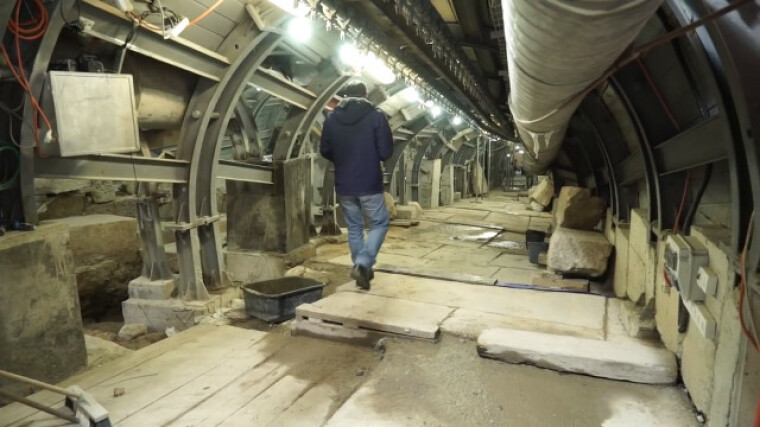Archaeologists unearth evidence of 2,000-year-old battle for Jerusalem

Archaeologists with the Israel Antiquities Authority have unearthed evidence of a battle that culminated in the destruction of Jerusalem nearly 2,000 years ago.
On Thursday, the Antiquities Authority unveiled relics from the battle, including well-preserved arrowheads and stone ballista balls, as part of Jerusalem's jubilee commemoration of the Six Day War.
According to The Jerusalem Post, the relics were found on the main road through the city to the Temple Mount.
In 66 A.D., Jewish rebels started barricading themselves within Jerusalem until they were defeated by the Roman army in 70 A.D. The Siege of Jerusalem ended with the sacking of the city and the destruction of the Second Temple.
"This battle is described by the historian Flavius Josephus [born 37 CE]: 'On the following day the Romans, having routed the brigands from the town, set the whole on fire as far as Siloam (Josephus, Wars, Book 6:363),'" the Antiquities Authority stated.
According to Nahshon Szanton and Moran Hagbi, the directors of the excavation, the ballista balls were fired by Roman catapults to bombard the city, while the arrowheads were used by the Jewish rebels.
The archaeologists also found a road running from the city's gates and the Pool of Siloam to the Temple.
"Recent research indicates that the street was built after Herod's reign, under the auspices of the Roman procurators of Jerusalem, and perhaps even during the tenure of the Roman governor Pontius Pilate, who is also known for having sentenced Jesus to death by crucifixion," Szanton said.
"This conclusion sheds new light on the history of Jerusalem in the late Second Temple period, and reinforces recognition of the importance of the Roman procurators' rule in shaping the character of Jerusalem," he added.
Aleteia reported that part of the road that has been discovered is 100 meters long by 7.5 meters wide and is paved with large stone slabs.
Hagbi noted that the current excavations are also aimed at exposing the area adjacent to the street, as well as the shops that were alongside it.
Dr. Yuval Baruch, the Antiquities Authority's Jerusalem region archaeologist, said that the researchers are expecting to unearth the entire length and width of the street within five years to complete the excavation of the site.
He noted that after the excavations, the remains of the street will be preserved and developed so that visitors will be able to walk along it.
 Christians don't have to affirm transgenderism, but they can’t express that view at work: tribunal
Christians don't have to affirm transgenderism, but they can’t express that view at work: tribunal Archaeology discovery: Medieval Christian prayer beads found on Holy Island
Archaeology discovery: Medieval Christian prayer beads found on Holy Island Presbyterian Church in America votes to leave National Association of Evangelicals
Presbyterian Church in America votes to leave National Association of Evangelicals Over 50 killed in 'vile and satanic' attack at Nigerian church on Pentecost Sunday
Over 50 killed in 'vile and satanic' attack at Nigerian church on Pentecost Sunday Ukrainian Orthodox Church severs ties with Moscow over Patriarch Kirill's support for Putin's war
Ukrainian Orthodox Church severs ties with Moscow over Patriarch Kirill's support for Putin's war Islamic State kills 20 Nigerian Christians as revenge for US airstrike
Islamic State kills 20 Nigerian Christians as revenge for US airstrike Man who served 33 years in prison for murder leads inmates to Christ
Man who served 33 years in prison for murder leads inmates to Christ


 Nigerian student beaten to death, body burned over ‘blasphemous’ WhatsApp message
Nigerian student beaten to death, body burned over ‘blasphemous’ WhatsApp message 'A new low': World reacts after Hong Kong arrests 90-year-old Cardinal Joseph Zen
'A new low': World reacts after Hong Kong arrests 90-year-old Cardinal Joseph Zen Iran sentences Christian man to 10 years in prison for hosting house church worship gathering
Iran sentences Christian man to 10 years in prison for hosting house church worship gathering French Guyana: Pastor shot dead, church set on fire after meeting delegation of Evangelicals
French Guyana: Pastor shot dead, church set on fire after meeting delegation of Evangelicals ‘Talking Jesus’ report finds only 6% of UK adults identify as practicing Christians
‘Talking Jesus’ report finds only 6% of UK adults identify as practicing Christians Mission Eurasia ministry center blown up in Ukraine, hundreds of Bibles destroyed: 'God will provide'
Mission Eurasia ministry center blown up in Ukraine, hundreds of Bibles destroyed: 'God will provide' Church holds service for first time after ISIS desecrated it 8 years ago
Church holds service for first time after ISIS desecrated it 8 years ago Burger King apologizes for 'offensive campaign' using Jesus' words at the Last Supper
Burger King apologizes for 'offensive campaign' using Jesus' words at the Last Supper Uganda: Muslims abduct teacher, burn him inside mosque for praying in Christ’s name
Uganda: Muslims abduct teacher, burn him inside mosque for praying in Christ’s name